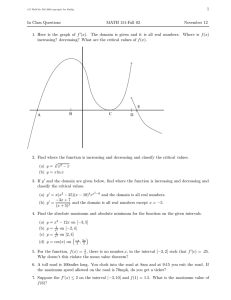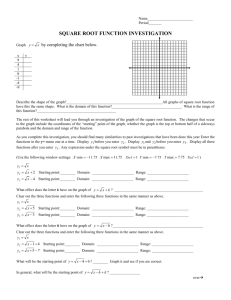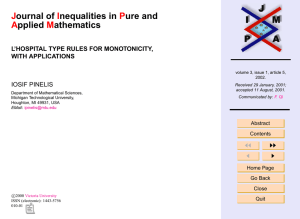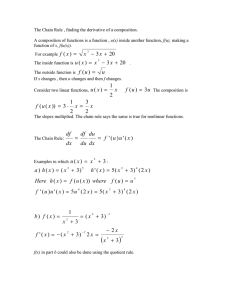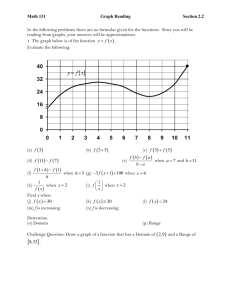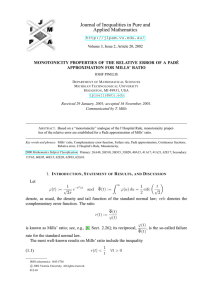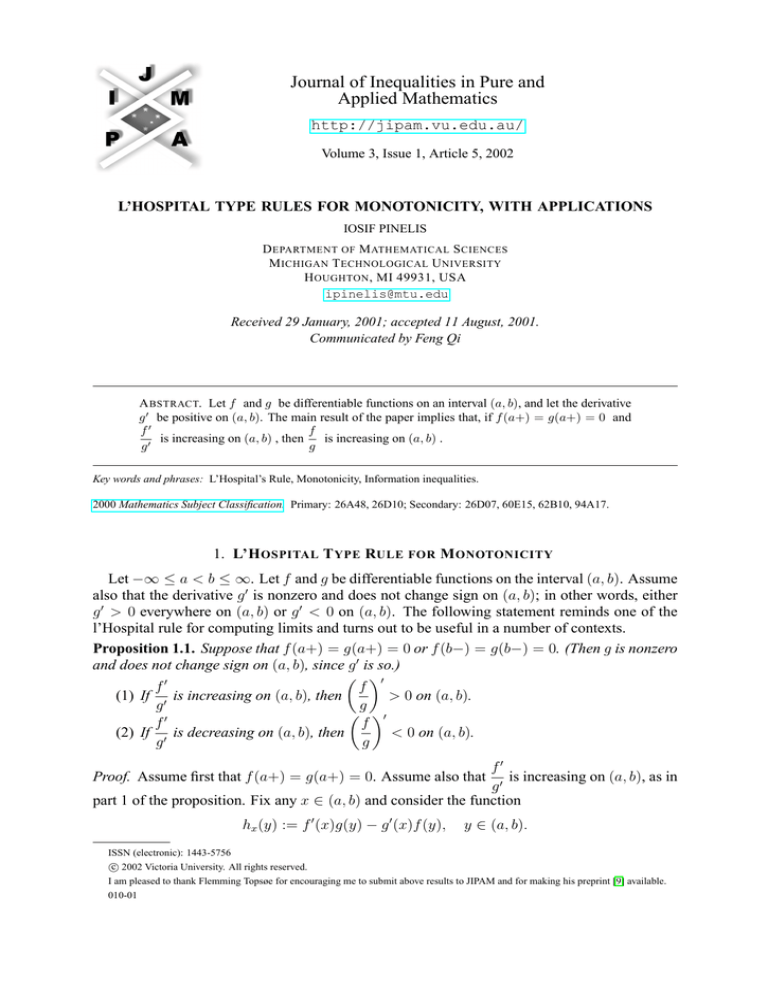
Journal of Inequalities in Pure and
Applied Mathematics
http://jipam.vu.edu.au/
Volume 3, Issue 1, Article 5, 2002
L’HOSPITAL TYPE RULES FOR MONOTONICITY, WITH APPLICATIONS
IOSIF PINELIS
D EPARTMENT OF M ATHEMATICAL S CIENCES
M ICHIGAN T ECHNOLOGICAL U NIVERSITY
H OUGHTON , MI 49931, USA
ipinelis@mtu.edu
Received 29 January, 2001; accepted 11 August, 2001.
Communicated by Feng Qi
A BSTRACT. Let f and g be differentiable functions on an interval (a, b), and let the derivative
g 0 be positive on (a, b). The main result of the paper implies that, if f (a+) = g(a+) = 0 and
f
f0
is increasing on (a, b) , then
is increasing on (a, b) .
g0
g
Key words and phrases: L’Hospital’s Rule, Monotonicity, Information inequalities.
2000 Mathematics Subject Classification. Primary: 26A48, 26D10; Secondary: 26D07, 60E15, 62B10, 94A17.
1. L’H OSPITAL T YPE RULE
FOR
M ONOTONICITY
Let −∞ ≤ a < b ≤ ∞. Let f and g be differentiable functions on the interval (a, b). Assume
also that the derivative g 0 is nonzero and does not change sign on (a, b); in other words, either
g 0 > 0 everywhere on (a, b) or g 0 < 0 on (a, b). The following statement reminds one of the
l’Hospital rule for computing limits and turns out to be useful in a number of contexts.
Proposition 1.1. Suppose that f (a+) = g(a+) = 0 or f (b−) = g(b−) = 0. (Then g is nonzero
and does not change sign on (a, b), since g 0 is so.)
0
f0
f
(1) If 0 is increasing on (a, b), then
> 0 on (a, b).
g
g
0
f0
f
(2) If 0 is decreasing on (a, b), then
< 0 on (a, b).
g
g
f0
is increasing on (a, b), as in
g0
part 1 of the proposition. Fix any x ∈ (a, b) and consider the function
Proof. Assume first that f (a+) = g(a+) = 0. Assume also that
hx (y) := f 0 (x)g(y) − g 0 (x)f (y),
y ∈ (a, b).
ISSN (electronic): 1443-5756
c 2002 Victoria University. All rights reserved.
I am pleased to thank Flemming Topsøe for encouraging me to submit above results to JIPAM and for making his preprint [9] available.
010-01
2
I OSIF P INELIS
This function is differentiable and hence continuous on (a, b). Moreover, for all y ∈ (a, x),
0
d
f (x) f 0 (y)
0
0
0
0
0
0
hx (y) = f (x)g (y) − g (x)f (y) = g (x)g (y)
− 0
> 0,
dy
g 0 (x)
g (y)
f0
is increasing on (a, b). Hence,
g0
the function hx is increasing on (a, x); moreover, being continuous, hx is increasing on (a, x].
Note also that hx (a+) = 0. It follows that hx (x) > 0, and so,
0
f
f 0 (x)g(x) − g 0 (x)f (x)
hx (x)
(x) =
=
> 0.
2
g
g(x)
g(x)2
because g 0 is nonzero and does not change sign on (a, b) and
This proves part 1 of the proposition under the assumption that f (a+) = g(a+) = 0. The proof
under the assumption that f (b−) = g(b−) = 0 is similar; alternatively, one may replace here
f (x) and g(x) for all x ∈ (a, b) by f (a + b − x) and g(a + b − x), respectively. Thus, part 1 is
proved.
Part 2 follows from part 1: replace f by −f .
Remark 1.2. Instead of the requirement that f and g be differentiable on (a, b), it would be
enough to assume, for instance, only that f and g are continuous and both have finite right
f+0
0
0
0
0
derivatives f+ and g+ (or finite left derivatives f− and g− ) on (a, b) and then use 0 (or, respecg+
f−0
f0
tively, 0 ) in place of 0 . In such a case, one would need to use the fact that, if a function h is
g−
g
continuous on (a, b) and h0+ > 0 on (a, b) or h0− > 0 on (a, b), then h is increasing on (a, b); cf.
e.g. Theorem 3.4.4 in [1].
The following corollary is immediate from Proposition 1.1.
Corollary 1.3. Suppose that f (a+) = g(a+) = 0 or f (b−) = g(b−) = 0.
f0
f
(1) If 0 is increasing on (a, b), then is increasing on (a, b).
g
g
f0
f
(2) If 0 is decreasing on (a, b), then is decreasing on (a, b).
g
g
Remark 1.4. The related result that any family of probability distributions with a monotone
likelihood ratio is stochastically monotone is well known in statistics; see e.g. [2] for this and
many other similar statements. For the case when f and g are probability tail functions, a proof
of Corollary 1.3 may be found in [3]. In fact, essentially the same proof remains valid for the
general setting, at least when the double integrals below exist and possess the usual properties;
f0
we are reproducing that proof now, for the readers’ convenience: if f (a+) = g(a+) = 0, 0 is
g
increasing on (a, b), g 0 does not change sign on (a, b), and a < x < y < b, then
ZZ
f (x) · (g(y) − g(x)) =
f 0 (u)g 0 (v) du dv
u∈(a,x)
v∈(x,y)
ZZ
(1.1)
<
g 0 (u)f 0 (v) du dv
u∈(a,x)
v∈(x,y)
= g(x) · (f (y) − f (x)) ,
J. Inequal. Pure and Appl. Math., 3(1) Art. 5, 2002
http://jipam.vu.edu.au/
L’H OSPITAL RULES FOR M ONOTONICITY
whence f (x)g(y) < g(x)f (y), and so,
3
f (x)
f (y)
<
; inequality (1.1) takes place because
g(x)
g(y)
f 0 (v)
f 0 (u)
<
, and so, f 0 (u)g 0 (v) < g 0 (u)f 0 (v). The proof in the case when one
g 0 (u)
g 0 (v)
has f (b−) = g(b−) = 0 instead of f (a+) = g(a+) = 0 is quite similar.
Ideas similar to the ones discussed above were also present, albeit implicitly, in [5].
Remark 1.5. Corollary 1.3 will hold if the terms “increasing” and “decreasing” are replaced
everywhere by “non-decreasing” and “non-increasing”, respectively.
u < v implies
2. A PPLICATIONS TO I NFORMATION I NEQUALITIES
In this section, applications of the above l’Hospital type rule to information inequalities are
given. Other applications, as well as extensions and refinements of this rule, will be given in a
series of papers following this one: in [7], extensions to non-monotonic ratios of functions, with
applications to certain probability inequalities arising in bioequivalence studies and to problems
of convexity; in [6], applications to monotonicity of the relative error of a Padé approximation
for the complementary error function; in [8], applications to probability inequalities for sums
of bounded random variables.
With all these applications, apparently we have only “scratched the surface”. Yet, even the
diversity of the cited results suggests that the monotonicity counterparts of the l’Hospital Rule
may have as wide a range of application as the l’Hospital Rule itself.
Consider now the entropy function
H(p, q) := −p ln p − q ln q,
where q := 1 − p and p ∈ (0, 1). In effect, it is a function of one variable, say p.
Topsøe [9] proved the inequalities
(2.1)
ln p · ln q ≤ H(p, q) ≤
ln p · ln q
ln 2
and
(2.2)
ln 2 · 4pq ≤ H(p, q) ≤ ln 2 · (4pq)1/ ln 4
for all p ∈ (0, 1) and also showed that these bounds on the entropy are exact; namely, they are
attained when p ↓ 0 or p = 1/2. Topsøe also indicated promising applications of bounds (2.2)
in statistics. He noticed that the bounds in (2.1) and (2.2), as well as their exactness, would
naturally be obtained from the monotonicity properties stated below, using also the symmetry
of the entropy function: H(p, q) = H(q, p).
Conjecture 2.1. [9] The ratio
ln p ln q
r(p) :=
H(p, q)
is decreasing in p ∈ (0, 1/2], from r(0+) = 1 to r(1/2) = ln 2.
Conjecture 2.2. [9] The ratio
ln
R(p) :=
H(p,q)
ln 2
ln (4pq)
1
1
is decreasing on (0, 1/2), from R(0+) = 1 to R
− =
.
2
ln 4
We shall now prove these conjectures, based on Proposition 1.1 of the previous section.
J. Inequal. Pure and Appl. Math., 3(1) Art. 5, 2002
http://jipam.vu.edu.au/
4
I OSIF P INELIS
Proof of Conjecture 2.1. On (0, 1),
f
,
g
where f (p) := ln p ln q and g(p) := H(p, q). Consider, for p ∈ (0, 1),
r=
f 0 (p)
r1 (p) := 0
=
g (p)
1
p
ln q − 1q ln p
ln q − ln p
;
r2 (p) :=
f 00 (p)
f2 (p)
=
,
00
g (p)
g2 (p)
where
f2 (p) := −(pq)2 f 00 (p) = p2 ln p + q 2 ln q + 2pq
and g2 (p) := −(pq)2 g 00 (p) = pq;
f20 (p)
2p ln p − 2q ln q + q − p
f200 (p)
=
;
r
(p)
:=
= −1 − ln pq.
4
g20 (p)
q−p
g200 (p)
Now we apply Proposition 1.1 repeatedly, four times. First, note that r4 is decreasing on (0, 1/2)
and f20 (1/2) = g20 (1/2) = 0; hence, r3 is decreasing on (0, 1/2). This and f2 (0+) = g2 (0+) =
0 imply that r2 is decreasing on (0, 1/2). This and f 0 (1/2) = g 0 (1/2) = 0 imply that r1 is
decreasing on (0, 1/2). Finally, this and f (0+) = g(0+) = 0 imply that r is decreasing on
(0, 1/2).
r3 (p) :=
Proof of Conjecture 2.2. On (0, 1/2),
R=
where F (p) := ln
H(p, q)
ln 2
F
,
G
and G(p) := ln (4pq). Next,
F0
F1
=
,
0
G
G1
F0
1
1 1
−
H(p, q). Further, 10 =
, where r2
where F1 (p) := ln q − ln p and G1 (p) :=
p q
G1
2 − r2
is the same as in the proof of Conjecture 2.1, and r2 is decreasing on (0, 1/2), as was shown.
F0
1
In addition, r2 < 2 on (0, 1). Hence, 10 =
is decreasing on (0, 1/2). Also, F1 (1/2) =
G1
2 − r2
F1
G1 (1/2) = 0. Now Proposition 1.1 implies that
is decreasing on (0, 1/2); hence, by (2.3),
G1
F0
is decreasing on (0, 1/2). It remains to notice that F (1/2) = G(1/2) = 0 and use once
G0
again Proposition 1.1.
(2.3)
It might seem surprising that these proofs uncover a connection between the two seemingly
unrelated conjectures – via the ratio r2 .
Concerning other proofs of Conjecture 2.1, see the final version of [9]. Concerning another
conjecture by Topsøe [9], related to Conjecture 2.2, see [7].
R EFERENCES
[1] R. KANNAN
1996.
AND
C.K. KRUEGER, Advanced Analysis on the Real Line, Springer, New York,
[2] J. KEILSON AND U. SUMITA, Uniform stochastic ordering and related inequalities, Canad. J.
Statist., 10 (1982), 181–198.
[3] I. PINELIS, Extremal probabilistic problems and Hotelling’s T 2 test under symmetry condition,
Preprint (1991).
J. Inequal. Pure and Appl. Math., 3(1) Art. 5, 2002
http://jipam.vu.edu.au/
L’H OSPITAL RULES FOR M ONOTONICITY
5
[4] I. PINELIS, Extremal probabilistic problems and Hotelling’s T 2 test under a symmetry condition,
Ann. Stat., 22 (1994), 357–368.
[5] I. PINELIS, On the Yao-Iyer inequality in bioequivalence studies. Math. Inequal. Appl. (2001),
161–162.
[6] I. PINELIS, Monotonicity Properties of the Relative Error of a Padé Approximation for Mills’ Ratio, J. Ineq. Pure & Appl. Math., 3(2) (2002), Article 20.
(http://jipam.vu.edu.au/v3n2/012_01.html).
[7] I. PINELIS, L’Hospital type rules for oscillation, with applications, J. Ineq. Pure & Appl. Math.,
2(3) (2001), Article 33. (http://jipam.vu.edu.au/v2n3/011_01.html).
[8] I. PINELIS, L’Hospital type rules for monotonicity: an application to probability inequalities
for sums of bounded random variables, J. Ineq. Pure & Appl. Math., 3(1) (2002), Article 7.
(http://jipam.vu.edu.au/v3n1/013_01.html).
[9] F. TOPSØE, Bounds for entropy and divergence
two-element set, J. Ineq. Pure & Appl. Math.,
(http://jipam.vu.edu.au/v2n2/044_00.html).
J. Inequal. Pure and Appl. Math., 3(1) Art. 5, 2002
for
2(2)
distributions over a
(2001), Article 25.
http://jipam.vu.edu.au/

